Is there a more ostentatious bird than the male of the Indian peafowl, the Peacock? I was introduced to this species at a very young age. Due to its popularity as an ornamental bird and its readiness to breed in captivity, Peafowl can be found in zoos, parks and gardens around the world. As with all species of captive wildlife, the bird achieves new levels of magnificence when seen in its natural habitat. I was fortunate to see, and photograph the national bird of India, wild in the National Parks of India and Sri Lanka.
I had become so accustomed to seeing them in captivity that I was taken by surprise when I saw my first wild bird. I hadn’t imagined them as a wild bird. Even the local pub where I grew up kept peacocks as a beer garden attraction. I loved the exotic call that they bellowed out, starting at sunrise and continuing throughout the day. It was this call that ultimately led to them being sold by the pub landlord, due to complaints about the noise from the neighbours.
My first experience of wild Peafowl came in India, while on safari in Ranthambhore National Park. The exotic cry in the dusty amber glow of the early morning sun set the heart racing; it was the first reminder of the morning that I was in the land of the Royal Bengal Tiger. Whilst beautiful in the morning light, he was a sorry looking chap, having lost the finery of his tail feathers. Still a magnificent sight, but a shadow of the bird that he could be.

The peacock has captured the imagination of humans and, indeed the gods since the beginning of time. The splendid bird features in the religious writings of Hinduism, Islam, Buddhism and Christianity as well as in Greco-Roman mythology. The iridescent light that fluoresced from the feathers was seen to be beauty from another realm, and the eyes of the display feather suggested all seeing wisdom. The bird is associated with compassion and the eternal life of resurrection. It is frequently depicted in art and architecture and the feathers have been used in ceremonial dress.
I encountered the importance of the peacock in Indian culture in the City Palace of Jaipur. The Northeast Peacock Gate is one of four courtyard gates, representing the four seasons and honouring Hindu gods. The Peacock Gate represents autumn and is dedicated the the god Vishnu, the great protector. The artwork is an extraordinary, intricate representation, but as is always the case when art represents nature, it falls short of capturing the beauty of the real peacock, as does this photographer.


A trip to Yala National Park, Sri Lanka presented me with my next peafowl encounter. In prime condition and full breeding plumage, these royal birds illuminated the grasslands, not just with their beauty but also with their bold personalities and extravagant displays.
Members of the pheasant family, there are 3 distinct species of peafowl:
- The Indian peafowl (India and Sri Lanka)
- The Green peafowl (Myanmar, Java and Indochina)
- The Congo peafowl (endemic to the Congo Basin in Africa)
The Indian peafowl is a large bird, weighing in at up to 6 Kg (13 lbs.) with a body length of up to 130 cm. (50 inches) and a tail train of over 1.5 meters (over 5 ft.). With the tail length taken in to consideration, this bird is a spectacular sight when in flight. In the wild, peafowl live for up to 20 years, assuming that their pretentious mating display does not attract the attention of tigers, leopards, jackal and the many other predators that stalk their native habitats. The peacock is not without means to defend itself, though. He is equipped with a powerful, sharp tooth like spur on the back of the leg, about 2.5 cm (1 inch) above the feet. These spurs are handy for scraps with other males or intimidating smaller predators but arguably no match for a tiger or leopard.
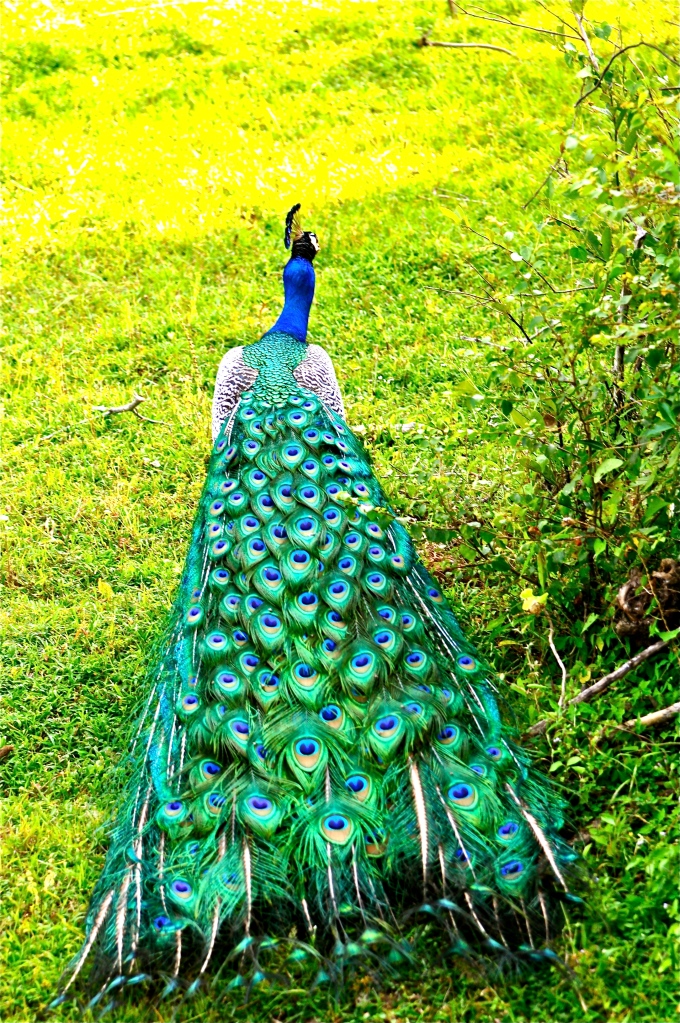
The peahen, perhaps unfairly, receives little attention from the photographer’s lens. She is usually stood alongside one of the most mesmerising birds on the planet. It is difficult to break the gaze from the peacock, even when he is not displaying. The peahen is, though, a beautiful bird in her own right. When placed alongside other robust ground dwelling birds around the world, such as pheasant, turkey and the various bush fowl, her iridescent green neck and spatulate crown feathers make her a match for any of them. We must also respect the fact that the peacock’s splendour has been designed for her benefit; she judges the grandeur of finery and splendour of the dance performance of this Prima Uomo.
The display sequence below was photographed from an open-top jeep. The stage was the dusty track; the theatre was Yala National Park. The peacock was just raising his extravagant train to present a fan of a hundred eyes, as we arrived to take our seats in the front row. His grandiose light show, equal to any firework display, was a captivating performance. The hundred eyes shimmered and sparkled as he vibrated his fan. Feathers swished and rustled as a field of corn does on a breezy day.
Recent research by Angela Freeman and James Hare of the University of Manitoba, Canada has discovered that the vibrating of the tail feathers creates a low pitch ‘infrasound’ below that which can be heard by the human ear but can be detected by other peafowl.
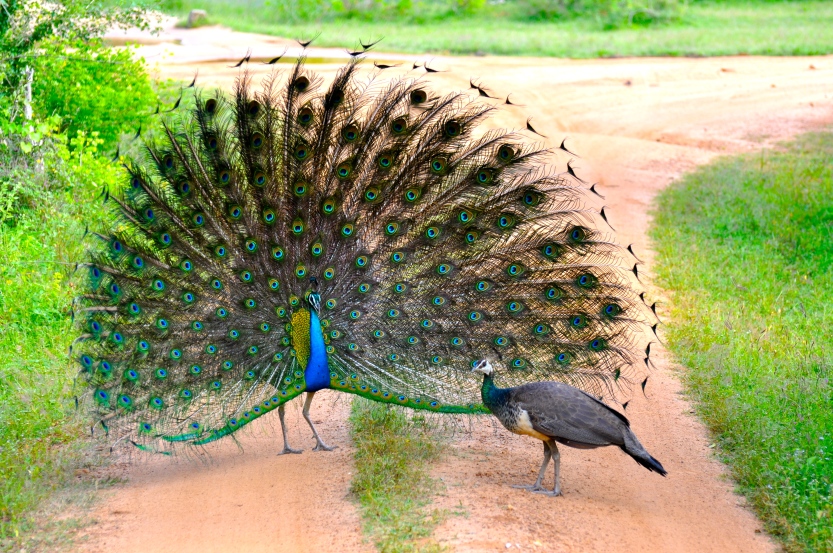
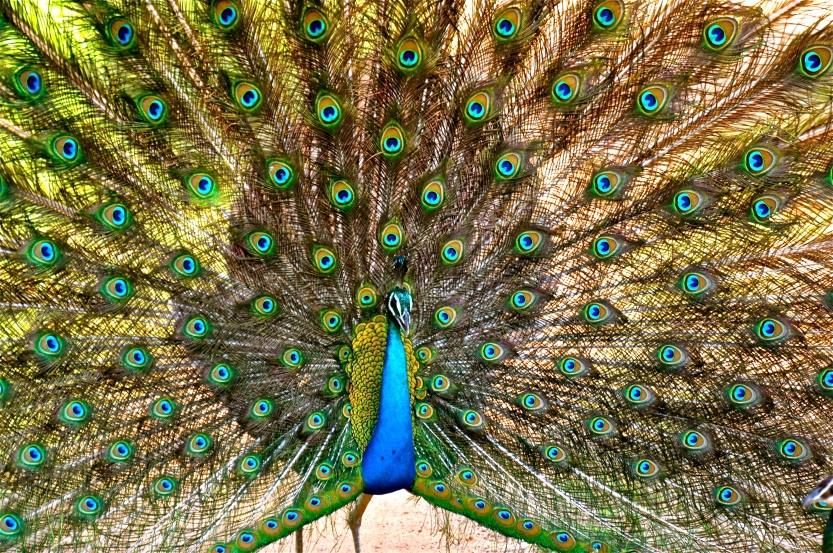

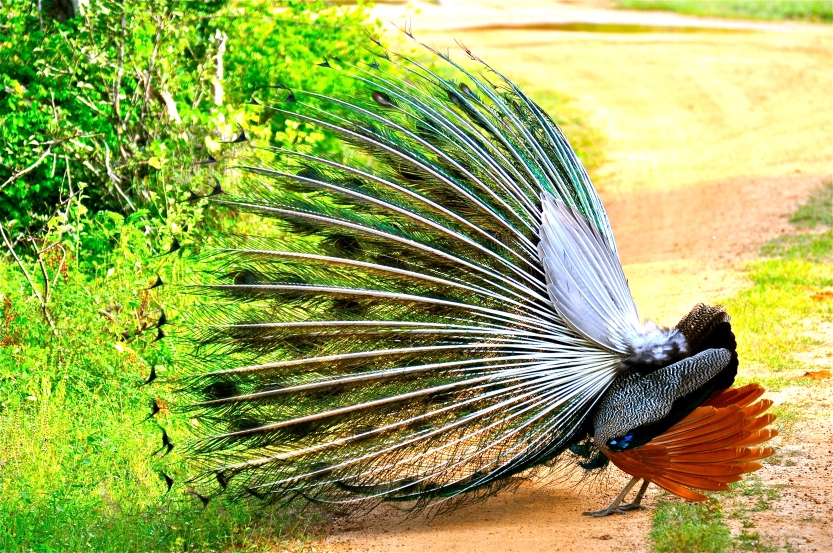

The performance, not for want of effort on the peacock’s part, ended unsuccessfully. Perhaps it was the first of the morning and the peahen wanted to keep her options open. It is her prerogative and she must find the strongest male to sire her offspring.

We were fortunate to see many peacock displays over the course of the day but it was the front row seats for this one made it an unforgettable experience. As the day came to an end, the sinking sun reflected the earth’s amber hue into the Sri Lankan sky. The peacocks left their stage for the night, preferring the safety of the trees. As the dying embers of light faded, only that familiar and yet exotic sound of the peacock broke the silence behind us as we left the park to the creatures of the night.
If you enjoyed this post, please follow Incidental Naturalist.
Comments and shares are welcomed.
Categories: Asia
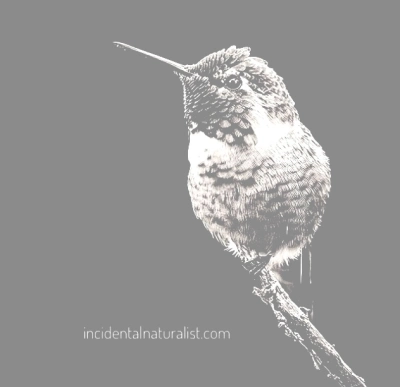




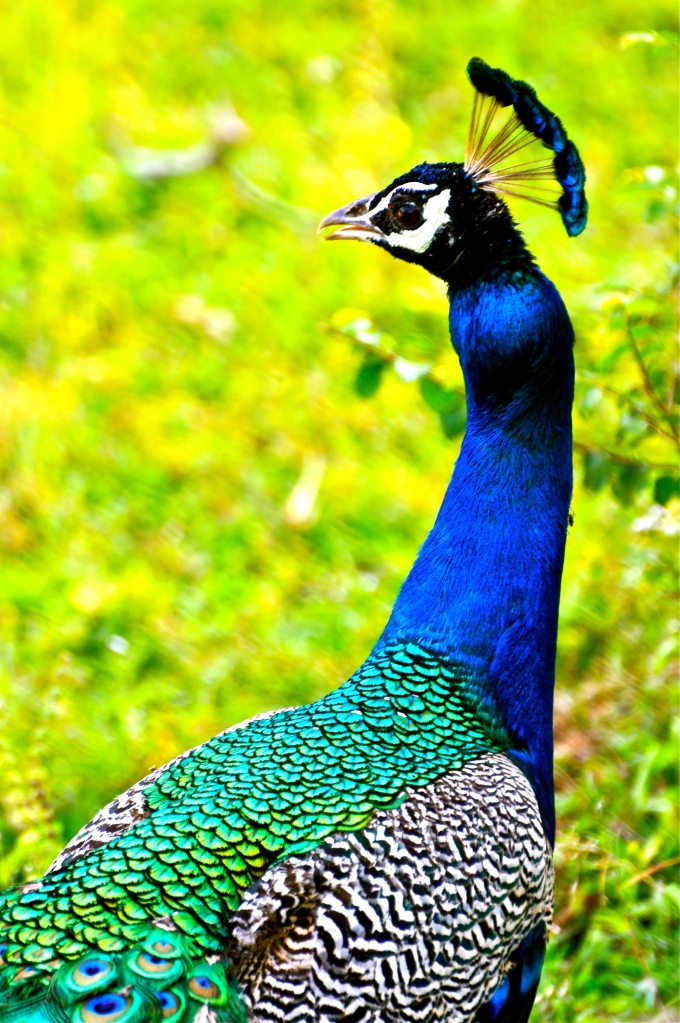

Thank you for a well-researched post. I first heard peacocks while visiting a friend in northeast Mississippi. We were having drinks one evening out on the patio when the peacock cry came across the fields. It was haunting. I never forgot it. You might be interested in a poem by Wallace Stevens that utilizes the cry of the peacocks very well, “Domination of Black.”
Great post. Thanks
LikeLiked by 2 people
Thanks for the great comment and for the poem recommendation. I found the poem and enjoyed it very much! That cry really is unforgettable.
LikeLiked by 2 people
You are most welcome! Your posts are terrific.
LikeLike
David, as always your posts are gorgeous and inspiring! I love the photos but how these magnificent birds intertwine into the history and cultures of India and Sri Lanka is fascinating. We tend to first think “tiger” when we think of wildlife in this part of the world – but there is so much more to see and understand. Isn’t nature amazing? We need to cherish and protect it – thanks for spreading the word.
LikeLiked by 2 people
Thanks for the great feedback, Roberta! India and Sri Lanka really are amazing places to view nature. Thank you also for keeping the wildlife and conservation conversation going!
LikeLike
wonderful!!
LikeLiked by 2 people
Impressive. Reminds me of the lengths, some women go to, cosmetical-wise, to impress human males. Way too much effort, it seems, for the prize to be won. But impressive, nevertheless
LikeLiked by 1 person
My grandparent’s had peacocks and peahens. I’ve always had a fondness for them because they never chased me like the geese did.
Seeing them in the wild must be just something!
LikeLiked by 2 people
Hi David,
Like you I was very surprised to see my first peacock in the wild, although they are not actually meant to be wild in Australia of course. My first one was standing in the middle of a country road and I thought I was imagining it to begin with and nearly ran over it! Your pictures are completely stunning, David. We humans can try to make beautiful things but when you look at something like a peacock’s feathers you realise we’ve got nothing on nature! Thank you for all the interesting background on these creatures too. I must confess I knew little of their history. Best wishes. J
LikeLiked by 2 people
Thanks again, Jane! Very encouraging comments. I will confess to one tiny little cheat that I hadn’t mentioned in the article – the image of the peafowl chick was taken, roaming wild, in Tasmania! So the Australian peacock isn’t so rare 🙂 The other images were taken in the National Parks of India or Sri Lanka.
LikeLiked by 1 person
This is going to sound incredibly childish, but “peafowl chick” made me burst out laughing (I have no idea why). It almost sounds like a delicious insult to throw at someone the next time I’m losing an argument.
LikeLiked by 1 person
Very amazing article going into more detail than I expected, in a good way of course 🙂
LikeLiked by 2 people
This story reminds me of seeing them in India and seeing some fly which somehow astounded me as I didn’t know they could. And I too have seen some with pretty shabby tail feathers and wondered what had happened to them. One must always keep up with the other peacocks for sure.
LikeLiked by 3 people
Great article! I actually wrote a blogpost on a similar, but slightly wider topic, of bird plumage and displays today (http://ninaseale.com/2015/10/24/bird-display-behaviour/) but I don’t have nearly as beautiful photos! You are so lucky to have seen wild peacocks!
LikeLiked by 2 people
Thanks for the encouraging comment and for connecting me to your blog. It is great!
LikeLiked by 1 person
I remember being in Saltwell Park, in Gateshead, ages ago, when I heard this ‘Waa-ah!’ screech. I nearly died of a heart attack, I turned around and saw the single most beautiful sight ever. Apparently, the Park owns a Peacock and Peahen, and the male was putting on a display for his ‘chick’. They are one the most astounding and incredible birds I’ve ever seen, possibly third to Raven and a Peregrine Falcon.
LikeLiked by 2 people
They truly are amazing! I am fortunate enough to have a peregrine falcon that hunts from the roof of my building. I always run to the window as it glides by.
LikeLiked by 2 people
I love them. I don’t see a lot of them, but I’ll always watch them on documentaries. All I see from time to time are Kites, in the North East England countryside.
LikeLiked by 2 people
Wonderful blog post.. I have actually had a couple of Male Peacocks-at separate times- fly over into my garden over the years here in Norfolk UK! They are truly beautiful..
LikeLiked by 2 people
Thanks for that great feedback! I love Norfolk. I have spent many a winters weekend there. There is something about the bleakness of a winters day on the Broads that I always found inviting. I always planned to move there but now I’m in New York. Not sure how that happened! 🙂
LikeLiked by 1 person
Thanks for replying.. Yeah I’ve lived on the Broads pretty much my whole life and still admire its wonder everyday..never take things for granted! 🙂
LikeLiked by 2 people
Stunning Peacock Photos!!
LikeLiked by 2 people
I love peacocks, their colours are so inspiring and the sheer explosion of that tail really demonstrates how vital sex is in nature. I remember seeing a captive peacock with his tail pretty much cut off; was a very sorry sight to see.
LikeLiked by 2 people
It really is amazing to see the difference between a peacock with a tail and one without. With his tail goes his confidence!
LikeLiked by 1 person
Love the different angles on these photos.
LikeLiked by 2 people
Reblogged this on everydayoraclestories and commented:
Love this!
LikeLiked by 1 person
Wonderful write up David. Quite some information you have posted there.
& yes the birds call are very distinct & one make out from quite a distant. You can see captured by me here:
https://pankajdhoot.wordpress.com/
Thanks,
Pankaj 🙂
LikeLiked by 2 people
Thanks for the kind comment, Pankaj! I look forward to following your blog. You are doing well to capture any bird photos with 5 children accompanying you 🙂
LikeLiked by 1 person
hahaha…. trying my patience 😉
thank you for your kind words 🙂
LikeLiked by 2 people
So Beautiful
LikeLiked by 2 people
How beautiful they are ! Thank you for the post !
LikeLiked by 1 person
I never knew what a peafowl looked like until now. They look quite unassuming actually. You wouldn’t think what they would grow up to become.
Thank you David 🙂
Shruthi
http://nyambura.co
LikeLiked by 1 person